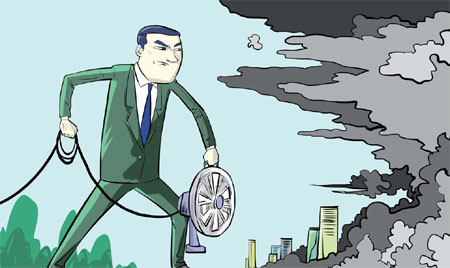China readies itself for CO2 emissions cap
Updated: 2014-08-29 09:23
By Lin Boqiang(China Daily Europe)
|
|||||||||||


Efforts now well underway to curb coal consumption, increase use of renewable energy
China is now the world's largest emitter of carbon dioxide, and there is talk that it is considering setting an absolute cap on such emissions from 2016.
Since early last year, nearly 30 Chinese provinces have been exposed to severe fog and haze. The frequency of haze in Chinese cities has sparked widespread complaints and calls for a clean-up. This pollution is essentially related to energy, which means an energy-centric approach to the problem is needed.
The Action Plan for Controlling Atmospheric Pollution, issued by the State Council last September, listed 10 measures to improve the management of air pollution. By and large the haze that envelops many parts of the country is due to high-energy use dominated by coal.
While the government measures are far reaching, other concrete measures have been proposed, including controlling energy use, speeding up the replacement of coal and stepping up the supply of clean energy. Replacing coal with other energy sources could greatly help reduce carbon emissions.
The government has proposed total energy consumption control. A recent policy also foresees reducing coal consumption in the regions of Beijing-Tianjin-Hebei, the Yangtze River Delta and the Pearl River Delta by 2017. These highly developed regions have been chosen because they are highly motivated to run cleaner economic structures, and they have a greater tolerance of the increased spending on energy as coal is replaced. Proposed total energy consumption control will affect GDP growth, the structure of the energy industry, industry in general and energy pricing.
The growth in demand for energy will slow. Over the past 30 years the ratio of GDP growth to the rise in primary energy consumption in China has been about 1 to 0.6 but has fallen to 1 to 0.5 over the past 10 years.
That ratio is expected to fall further, to 1 to 0.4, over the next 10 years, reducing the dependency of economic growth on energy. In general, slower growth in energy demand can be explained by the economic slowdown, structural industrial adjustment toward reduced energy-intensive growth and higher energy costs due to the cleaning-up of the air.
China's coal-dominated energy structure will be adjusted in favor of clean energies. The authorities are being tough on curbing coal consumption to reduce the share of coal in primary energy to 65 percent by 2017. This could be easily achieved, as the share of coal was 65.7 percent last year, and over the past three years the proportion of coal in primary energy consumption has fallen 1 percent a year.
One principal aim of the air pollution clean-up is coal substitution. In 1978 just 610 million tons of coal was used, and but that had soared to 3.61 billion tons last year, accounting for 49.3 percent of the world's total consumption.
The path to substituting coal is clear - natural gas in the short term and other clean energy sources in the medium to long term. Natural gas' share of primary energy consumption was just 5.9 last year, but China is raising its incoming supplies, including a recent Russo-Chinese gas deal of 30 billion cubic meters.
Research by the China Center for Energy Economics Research indicates that coal consumption may peak by 2020 at an estimated 4.2 billion tons. But timing of the peak will depend on factors such as government determination to ensure cleaner air, clean energy developments, implementation of a carbon tax, energy pricing reforms and, especially, coal gasification (also supported by the 10 measures) and coal liquefaction development. The curbing of coal consumption and the expected consumption peak are particularly favorable for a cap on CO2 in coming years. If that peak came in 2020, with the expected growth of nuclear power and renewable, a CO2 emissions peak could be safely expected.
China's energy pricing reforms will be speeded up. In fact, there are no significant technical challenges to clearing away the country's air pollution. But one key issue is how to pay for it. At present, coal substitution and clean energy development could be achieved through higher energy costs. For historical reasons, China's energy prices are regulated by the government by applying cost- plus-pricing principles. The public is accustomed to relatively low energy prices and consequently is sensitive to any price increase. Energy pricing reforms are subject to affordability and people's willingness to pay, and have been slow.
Cost-sharing has become a major issue in the cleaning-up process and is expected to affect not only the process itself but also its pace. With current levels of air pollution, the public is likely to be willing to contribute more to clean-up costs.
This, together with better energy supply, is good for energy pricing reforms, and the government is exploring this opportunity. China carried out natural gas pricing reforms last year and coal resource tax reform, and electricity tariff reforms are in the offing this year.
Coal substitution requirements and energy pricing reforms will together favor development of renewable energy and clean energy. China's renewable energy sources have grown rapidly in recent years. Last year, electricity capacity was 1,247 gigawatts, and wind and solar power increased 16 gW and 11 gW respectively, increasing the proportion of non-fossil fuel generation capacity to 31 percent, with large hydro generation at 15 per cent.
Thanks to energy pricing reforms, competitiveness of renewable energy in China could be improved by increasing the cost of fossil fuels. China aims for 18 gW of wind power and 14 gW of solar power this year and is promoting distributional energy. Nuclear power satisfies both cost and clean criteria, and more nuclear power plants are on their way.
The Energy Information Administration estimates that in 2011, China's shale gas reserves were the largest in the world, at 14.3 percent of the total. Shale gas development has been slow, with output of 200 million cubic meters last year.
The success of US shale gas is of much interest to China. If China could produce shale gas equivalent to last year's US output, China could substitute close to 10 percent of coal's primary energy share at present consumption levels.
But shale gas production in China would have to increase significantly for this to be possible.
Energy pricing reforms will be particularly good for energy conservation and CO2 emission reduction. The Chinese government has initiated energy conservation and emission reduction targets since 2006 but they have been vague for the public. However, air pollution will encourage more direct and measurable targets for governments at all levels to be set.
Meanwhile, clean-up efforts have introduced more specific energy conservation measures. For the central government, these will include targets for total energy control and reducing emissions of major pollutants. For local governments, many emissions reduction measures have also been set out.
For example, the Tianjin government announced that it would no longer approve new capacity-expansion projects in energy-intensive industries such as steel, cement and non-ferrous metals.
The air pollution clean-up will require technological progress and management models, and will provide great opportunities to domestic and foreign companies in environmental technologies and management. In particular, management of energy-efficiency projects will benefit.
In addition, China is also promoting electric vehicles and efficient buildings. Recent policies have specifically supported electric vehicles, including administrative measures to force government agencies to procure electric vehicles and housing developers to build electricity charging facilities, and additional subsidies (tax exemption) for buying electric vehicles. The government is expected to come up with stricter policies for building efficiency, possibly in connection with distributional energy.
The author is director of the China Center for Energy Economics Research at Xiamen University. The views do not necessarily reflect those of China Daily.
(China Daily European Weekly 08/29/2014 page11)
Today's Top News
Obama says 'no IS strategy yet'
China calls for ceasefire in Ukraine
British PM stresses advantages for Scotland to stay in Britain
Girl, 9, kills shooting range instructor
IMF chief Lagarde investigated in graft case
1,400 children exploited in UK town
China, Russia enhance military ties
Turkish FM elected as premier
Hot Topics
Lunar probe , China growth forecasts, Emission rules get tougher, China seen through 'colored lens', International board,
Editor's Picks

|

|

|

|

|

|





